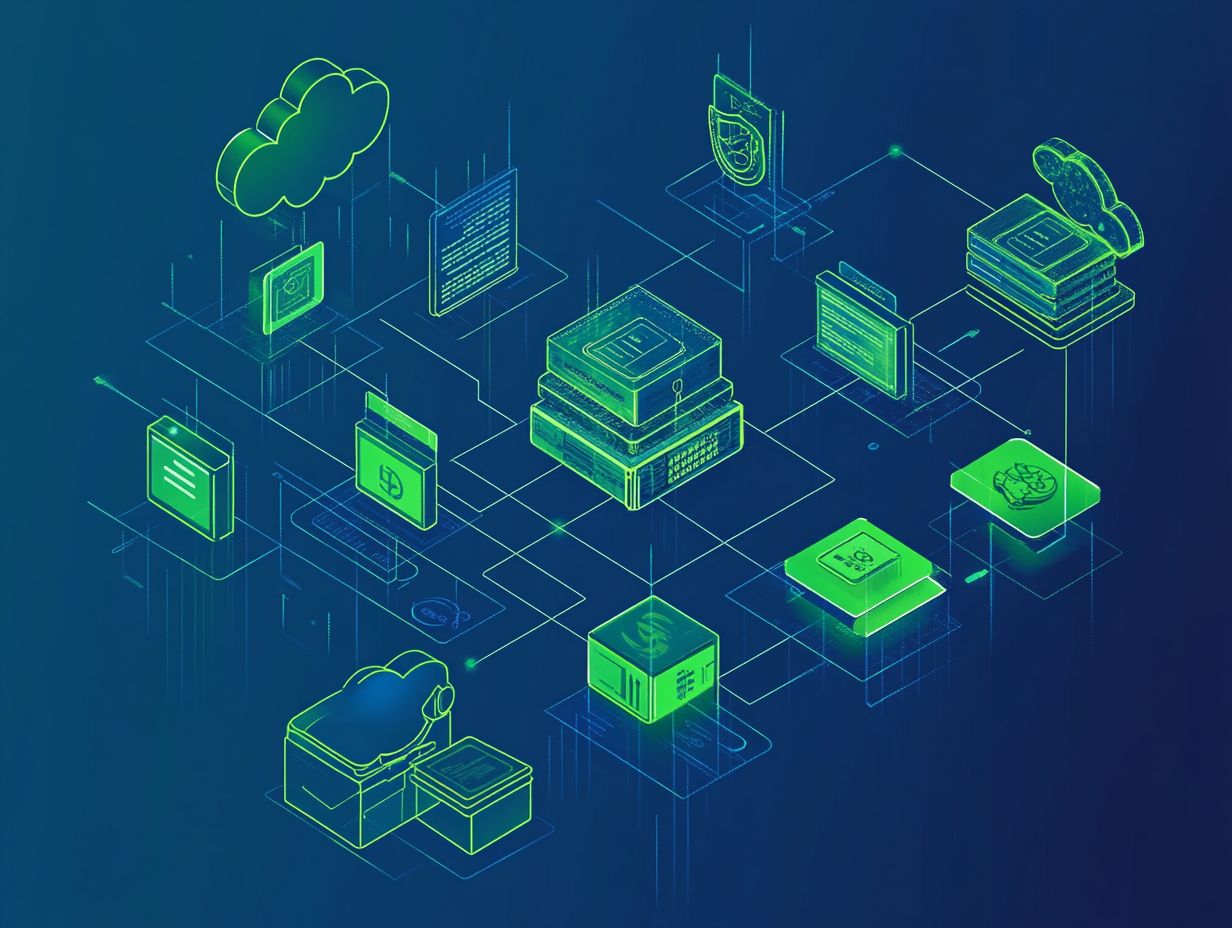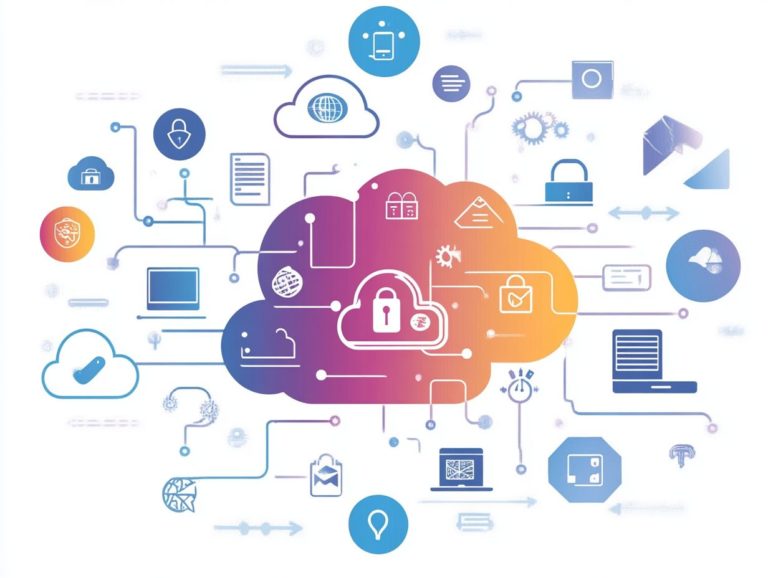5 Steps to Achieve Cloud Security Compliance
In today s digital landscape, ensuring cloud security compliance is vital for your business. Protecting sensitive data and maintaining trust with your customers is crucial.
This article outlines five essential steps to help you navigate the complexities of cloud security. You ll learn about:
- Understanding compliance standards
- Conducting thorough risk assessments
- Implementing robust security controls
- Preparing for audits
Everything you need to know will be covered!
You ll also uncover common challenges and learn best practices to keep your cloud environment secure.
Are you ready to elevate your cloud security? Let s dive in!
Contents
- Key Takeaways:
- 1. Understand the Cloud Security Compliance Standards
- 2. Conduct a Risk Assessment
- 3. Implement Security Controls and Policies
- 4. Regularly Monitor and Update Security Measures
- 5. Prepare for Audits and Compliance Certifications
- What Are the Common Challenges in Achieving Cloud Security Compliance?
- How Can a Business Determine Which Compliance Standards Apply to Them?
- What Are the Key Components of a Risk Assessment for Cloud Security?
- How Can a Business Choose the Right Security Controls and Policies for Their Cloud Environment?
- What Are the Best Practices for Monitoring and Updating Cloud Security Measures?
- How Can a Business Prepare for and Pass Compliance Audits and Certifications?
- Frequently Asked Questions
- What is cloud security compliance and why is it important?
- What are 5 steps to achieve cloud security compliance?
- How do I identify compliance requirements for my organization?
- What types of security controls should I implement to achieve compliance?
- How often should I monitor and audit my cloud security compliance?
- What steps should I take to stay up-to-date with compliance standards and regulations?
Key Takeaways:

Understand the various cloud security compliance standards to ensure proper adherence.
Conduct a thorough risk assessment to identify potential vulnerabilities and mitigate risks.
Implement and regularly update security controls and policies to maintain compliance.
1. Understand the Cloud Security Compliance Standards
Understanding how to ensure compliance in cloud security standards is vital for your business. It helps protect sensitive data and cultivate a robust security posture in cloud environments.
Regulations like PCI-DSS (Payment Card Industry Data Security Standard), ISO 27001, and GDPR significantly influence your cloud security strategies and compliance practices. These standards serve as a roadmap for safeguarding your data and clarify the shared responsibility model between your organization and cloud service providers (CSPs).
By grasping these compliance requirements, you ensure that both you and your CSPs are fulfilling your obligations, fostering a secure cloud environment. For guidance, follow these 5 steps to create a cloud security policy.
Continuous monitoring and vulnerability management are critical components. They allow you to identify and mitigate risks in real-time. Proactively managing vulnerabilities and consistently monitoring your cloud infrastructure helps maintain compliance, reduces potential legal repercussions, and enhances overall trust with your clients.
2. Conduct a Risk Assessment
Conducting a thorough risk assessment is crucial for identifying security risks in cloud environments. This enables effective infrastructure protection strategies and robust security policies tailored to your unique challenges.
The process starts with identifying your critical assets, which can range from sensitive data to essential applications. Once you ve pinpointed these assets, evaluating potential threats becomes imperative. This involves examining both external and internal factors that could pose risks.
Assessing vulnerabilities within your infrastructure is equally important as it uncovers weaknesses that threat actors might exploit. Involving your incident response teams throughout this process boosts the assessment’s accuracy and helps craft proactive security measures.
Collaboration ensures that your security protocols are comprehensive and responsive, fostering an environment of preparedness against ever-evolving cyber threats.
3. Implement Security Controls and Policies
Implementing robust security controls and policies is essential for safeguarding data in cloud environments. Incorporating best practices like Identity Access Management (IAM) a system that controls who can access what information and multi-factor authentication ensures secure user access and compliance with regulatory standards.
To establish a comprehensive security framework, consider technical controls such as encryption and firewalls to protect your data both at rest and in transit. Administrative controls, like security training and incident response planning, empower your staff to recognize and tackle potential threats effectively.
Don t overlook physical controls; ensuring that your infrastructure housing sensitive data is secure and monitored is crucial. Automated tools can streamline the implementation of these varied policies, enabling efficient user access management, continuous monitoring of systems for vulnerabilities, and swift responses to security incidents.
This proactive approach enhances the overall resilience of your security architecture.
Act now to protect your data! Start implementing these steps immediately to enhance your cloud security and ensure you’re aware of cloud security compliance.
4. Regularly Monitor and Update Security Measures

Regularly monitoring and updating your security measures is essential for maintaining an effective security posture. This practice allows you to quickly identify and respond to security incidents, minimizing the risk of data breaches and ensuring ongoing compliance with ever-evolving regulations.
Using advanced technologies such as artificial intelligence and machine learning algorithms can significantly enhance your monitoring efforts. These solutions streamline the identification of anomalies and facilitate real-time compliance checks across various frameworks.
Developing a robust breach planning strategy is crucial. This includes clear response protocols, regular employee training, and simulations of potential security incidents. By preparing in advance, you ensure a swift and coordinated response, which can greatly reduce the impact of a security breach when it occurs.
5. Prepare for Audits and Compliance Certifications
Preparing for audits and compliance certifications requires a proactive approach to security assessments and the establishment of a comprehensive governance framework. Understanding the relationship between cloud security and compliance ensures your cloud security strategy aligns seamlessly with relevant regulatory standards and best practices.
To kick off this journey, conduct thorough internal assessments. Evaluate your current policies, practices, and technology to pinpoint potential gaps.
After this initial review, consider engaging with third-party auditors. They will provide an unbiased perspective on your compliance readiness, offering valuable insights and recommendations that clarify areas needing attention.
Fostering a culture of compliance throughout your organization can significantly streamline audit processes. As employees become aware of their responsibilities and the importance of adhering to regulations, this cultural shift enhances accountability and promotes continuous improvement, making audits feel less daunting and more integrated into daily operations.
What Are the Common Challenges in Achieving Cloud Security Compliance?
Don’t let the challenges of cloud security compliance hold you back! Tackle them head-on as you navigate the intricacies of compliance regulations and the ever-evolving landscape of security risks. To succeed, learn how to maintain cloud compliance and adapt your security best practices continuously.
Many organizations face significant obstacles due to misalignment between cloud service providers and specific compliance requirements. This complicates the assurance that all aspects of operations meet necessary standards.
User access management often exposes vulnerabilities that can pose risks if not meticulously handled. If a security incident arises, it can thrust your organization into compliance jeopardy, unveiling gaps that demand immediate attention.
To proactively confront these challenges, you can:
- Conduct regular risk assessments, which are reviews of potential security threats to your systems.
- Invest in robust training programs for employees.
- Establish clear communication channels with service providers.
By fostering a collaborative environment that aligns compliance efforts with your business objectives, you can navigate the complexities of cloud security with confidence. For more insights, check out this guide on managing cloud compliance.
How Can a Business Determine Which Compliance Standards Apply to Them?
Determining the applicable compliance standards for your business requires a nuanced understanding of the regulatory landscape relevant to your industry, geographical location, and the specific services provided by cloud service providers.
To navigate this intricate terrain effectively, begin with a comprehensive risk assessment to identify potential vulnerabilities and compliance gaps.
Once you have that foundation, consulting with legal experts who specialize in regulatory matters can offer critical, tailored insights that align with your business needs.
It’s equally important to analyze industry-specific compliance frameworks, such as GDPR for data protection or HIPAA for health information, ensuring that necessary measures are firmly in place.
Continuous monitoring is essential. Regularly updating your compliance strategies to reflect changes in regulations will help you avoid costly oversights and maintain the trust of your clients and stakeholders.
What Are the Key Components of a Risk Assessment for Cloud Security?

A comprehensive risk assessment for cloud security involves several key components that you should pay close attention to:
- Identifying security risks
- Assessing weaknesses
- Evaluating your existing security posture
- Establishing an effective incident response plan
Each of these elements is essential for developing a thorough understanding of potential threats. For example, identifying security risks often leverages methodologies like threat modeling, which helps you pinpoint where weaknesses reside within your cloud environment. Tools such as the OWASP Cloud-Native Application Security Top 10 can illuminate common pitfalls you need to be cautious of.
Assessing weaknesses involves practices like penetration testing and automated scanning with tools like Nessus or Qualys, offering valuable insights into any vulnerabilities that may exist.
Evaluating your existing security posture typically involves analyzing the policies, practices, and technologies you already have in place, often guided by frameworks like NIST or CIS.
Finally, establishing an effective incident response plan ensures that your team is well-prepared to respond to breaches swiftly, utilizing playbooks and simulation exercises to refine their responses. Together, these interconnected components create a holistic view, enabling you to proactively safeguard your cloud assets.
How Can a Business Choose the Right Security Controls and Policies for Their Cloud Environment?
Choosing the right security controls and policies for your cloud environment requires a thoughtful evaluation of your organization s data protection needs, the capabilities of Identity and Access Management (IAM) which ensures the right individuals have access to the right resources at the right times and the specific characteristics of the cloud technologies you re using.
A variety of factors play a crucial role in shaping this decision-making process. Compliance requirements, like industry standards and legal regulations, can dictate the necessary security measures to ensure that your sensitive data remains protected from potential breaches.
Your organization s structure its size and how teams are distributed can also impact how these security protocols are rolled out. Given the ever-evolving threat landscape, continuously assessing weaknesses is vital.
For example, imagine a financial institution skillfully deploying multi-factor authentication across its cloud services, which greatly cuts down the risk of unauthorized access. Meanwhile, a healthcare provider might implement robust encryption techniques to safeguard patient data, ensuring compliance with HIPAA regulations.
Tailor your approach to meet your unique needs and challenges!
What Are the Best Practices for Monitoring and Updating Cloud Security Measures?
The best practices for monitoring and updating your cloud security measures center around implementing automated tools designed for continuous oversight. This ensures that you can make timely updates to address emerging threats and maintain compliance with regulatory standards.
These automated tools also provide significant enhancements to your visibility into potential weaknesses. Integrating security information and event management (SIEM) solutions can further bolster your defenses. Utilizing threat intelligence feeds enables you to stay ahead of evolving threats by providing actionable insights into the latest cyber risks.
Conducting regular security assessments allows you to identify weaknesses in your systems before they become liabilities.
By fostering a proactive security approach, you can not only respond more effectively to incidents but also cultivate a culture of security awareness that empowers your employees to be vigilant and informed.
Start implementing these best practices today to secure your cloud environment!
How Can a Business Prepare for and Pass Compliance Audits and Certifications?
Are you ready to ace your compliance audits? With a solid governance framework and active teamwork, your business can shine in cloud security management!
Preparing for and successfully navigating compliance audits and certifications demands a meticulously crafted governance framework, regular security assessments, and collaboration among all stakeholders involved in your organization s cloud security strategy.
To forge a robust approach, begin by establishing clear compliance goals that align with industry standards and complement your business objectives. Specify the frameworks you intend to follow, such as the International Organization for Standardization (ISO), the National Institute of Standards and Technology (NIST), or the General Data Protection Regulation (GDPR), tailored to your sector’s unique requirements.
Next, closely examine your existing documentation. Assess your current policies, procedures, and any previous audit findings to pinpoint areas that need improvement.
Conduct mock audits to mimic real audit conditions! These can reveal gaps and test your response strategies. Involving third-party auditors can provide an impartial perspective, helping uncover overlooked vulnerabilities and strengthening your overall compliance framework.
Frequently Asked Questions

What is cloud security compliance and why is it important?
Cloud security compliance means following specific rules to keep data safe in the cloud. It is vital because it helps protect sensitive information and ensures that organizations meet legal and industry requirements for data protection.
What are 5 steps to achieve cloud security compliance?
The 5 steps to secure your cloud environment for achieving cloud security compliance are: 1) Identify compliance requirements, 2) Assess current security measures, 3) Implement security controls, 4) Monitor and audit regularly, and 5) Stay up-to-date with compliance standards and regulations.
How do I identify compliance requirements for my organization?
To identify compliance requirements, research and understand the laws and regulations that apply to your organization and industry. Consult with compliance experts and review any contractual obligations with your cloud service provider.
What types of security controls should I implement to achieve compliance?
The specific security controls will vary based on your organization and compliance requirements. Common controls include access controls, encryption, regular data backups, and monitoring systems for suspicious activity. Work with your cloud service provider to ensure that these controls are in place and properly configured.
How often should I monitor and audit my cloud security compliance?
To maintain compliance, regularly monitor and audit your security measures. This could range from daily checks to quarterly or annual audits, depending on the level of risk and compliance requirements for your organization. Establish a schedule and stick to it for consistent monitoring and auditing.
What steps should I take to stay up-to-date with compliance standards and regulations?
To stay current with compliance standards and regulations, regularly review any changes to relevant laws. Stay informed about industry-specific compliance requirements and consult with experts as needed. Additionally, regularly update your security measures to ensure they meet current standards.






